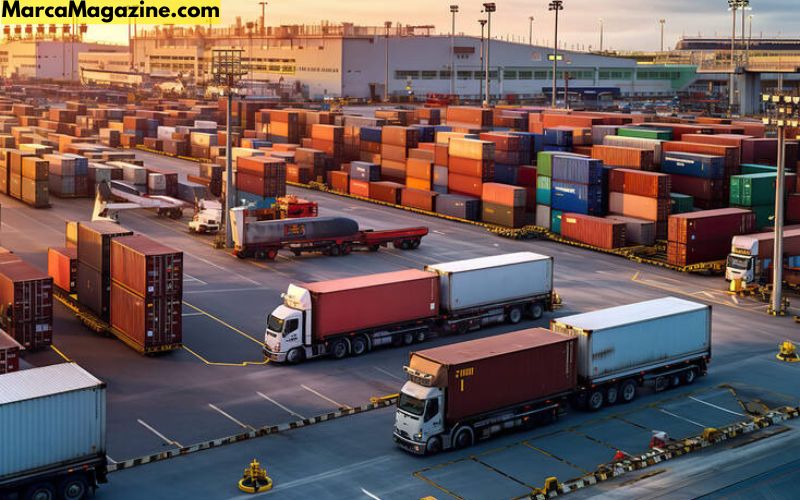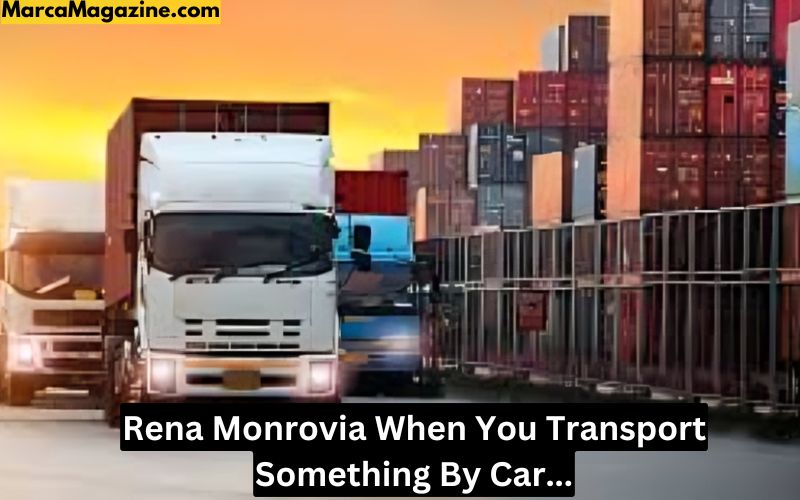Transporting goods, personal belongings, or even vehicles themselves by car is an essential function in the global economy. The processes involved in this kind of transportation can range from simple point-to-point deliveries to complex logistical operations that cross state or national borders. Understanding the intricacies of car transport services is critical for businesses, consumers, and even individuals looking to move their belongings across long distances. In this article, we will explore the various facets of transporting goods by car, using Rena Monrovia as an example—a fictional logistics expert—to walk through the steps involved in car-based transportation.
Introduction to Car-Based Transportation
Transporting goods or personal items by car can be an efficient and flexible option, offering control over the route, timing, and nature of the transported items. It is particularly advantageous for local or regional trips where other transportation methods, such as air or rail, might be impractical or unnecessary. This mode of transport can also be highly customizable, allowing for specific handling requirements depending on the nature of the goods.
Rena Monrovia, a logistics consultant specializing in automotive transportation, emphasizes that although moving items by car can seem straightforward, it often requires careful planning. The goal, she suggests, is to ensure a smooth journey while avoiding potential challenges such as regulatory hurdles, vehicle maintenance issues, or inefficiencies in route planning.
The Essentials of Car Transport
When transporting something by car, several key elements must be considered:
- Type of Goods: The nature of the item being transported dictates much of the planning. For example, fragile goods require extra protection, hazardous materials have strict regulations, and large items might require special vehicles such as trucks or vans.
- Distance: The distance between the origin and destination can determine the type of vehicle used and the necessary stops along the way. Short distances can often be handled by personal vehicles, while longer distances may require commercial services with drivers experienced in long-haul transport.
- Regulations: Different regions have specific rules and regulations governing car transportation, particularly when it comes to commercial deliveries. For example, crossing state or national borders often requires additional paperwork, inspections, and adherence to customs laws.
- Weather and Road Conditions: Environmental factors play a significant role in the safety and efficiency of car transport. Poor weather conditions such as rain, snow, or extreme heat can cause delays, vehicle damage, or accidents.
- Cost Efficiency: Fuel costs, tolls, maintenance, and driver wages are key contributors to the total cost of transport by car. Optimizing routes and ensuring that vehicles are well-maintained can help keep expenses manageable.
Rena Monrovia believes that the secret to efficient car transport lies in meticulous planning, anticipating challenges, and always having a backup plan. Let’s delve deeper into some of the key aspects of car transport services.
Planning and Preparation: The Backbone of Successful Transport
Transporting goods by car begins long before the actual journey. A successful trip requires careful planning, which can be broken down into several steps.

1. Identifying the Right Vehicle
Choosing the right vehicle is paramount. The vehicle needs to match the size, weight, and nature of the cargo. For instance:
- Sedans and Compact Cars: Ideal for small, lightweight items or personal belongings. These vehicles are best for short distances or city transport.
- SUVs and Pickup Trucks: Suitable for bulkier items, moderate distances, or rugged terrains. Pickup trucks are especially useful for transporting construction materials or furniture.
- Vans: These are often used for transporting larger quantities of goods over medium distances. They offer more storage space than a sedan while still being manageable in urban areas.
- Box Trucks and Trailers: These are preferred for moving large volumes of goods across longer distances. Trailers, in particular, are often used in professional moving services and long-haul transport.
According to Monrovia, selecting the right vehicle reduces the risk of damage, improves fuel efficiency, and ensures the cargo fits securely.
2. Route Optimization
After selecting the vehicle, the next critical step is planning the route. Route optimization helps in minimizing costs (primarily fuel and tolls) and avoiding unnecessary delays caused by traffic, construction, or road conditions.
- Navigation Tools: GPS technology and route-planning apps like Google Maps or Waze can provide real-time traffic data, helping drivers choose the fastest or most fuel-efficient routes.
- Backup Plans: Monrovia advises always having a secondary route in case the primary road becomes inaccessible due to weather, accidents, or unforeseen road closures.
- Stopping Points: On long trips, drivers will need to stop for fuel, food, or rest. Identifying safe, efficient stopping points in advance is crucial to maintaining a consistent pace.
Regulatory Considerations: Legal Compliance is Non-Negotiable
Transporting goods by car, especially across state or international borders, comes with regulatory considerations that can’t be ignored. Even within a single country, various jurisdictions might have differing requirements for the transport of certain goods.
1. Licensing and Permits
Different vehicles require different types of licenses and permits. For example:
- Commercial Driver’s License (CDL): In most countries, larger vehicles such as trucks and vans require drivers to hold a CDL. The requirements for this license vary depending on the jurisdiction.
- Permits for Specific Goods: Some goods, such as hazardous materials, require special permits. In the U.S., for instance, transporting dangerous goods is regulated by the Department of Transportation, and there are strict rules about how such materials must be packaged and labeled.
2. Crossing Borders
For international transport, crossing borders is one of the most challenging aspects of car transport. This process often involves:
- Customs Documentation: When moving goods across international borders, customs paperwork is necessary. This paperwork outlines the nature of the goods, their value, and other important details that customs agents will review.
- Taxes and Tariffs: Depending on the goods being transported, there may be taxes or tariffs that need to be paid before they can cross into another country. Monrovia warns that failure to pay these fees can result in significant delays or even the confiscation of goods.
Safety First: Securing Goods for Transport
Ensuring that goods are transported safely is one of the top priorities in car-based logistics. A variety of measures can be taken to reduce the risk of damage or loss.
1. Proper Packaging
Packaging is one of the most important steps in ensuring that goods arrive at their destination in good condition. Rena Monrovia emphasizes that fragile items should be wrapped in protective materials such as bubble wrap or foam and packed securely to prevent shifting during transport.
- Boxes and Containers: Sturdy boxes or plastic containers are essential for protecting goods from external factors such as moisture, dust, or impact.
- Labeling: Proper labeling helps drivers and loaders handle goods carefully. Labels such as “fragile,” “this side up,” or “hazardous materials” can prevent accidents and ensure compliance with transport regulations.
2. Securing Items Inside the Vehicle
Even if goods are packaged properly, they need to be secured within the vehicle to prevent them from shifting during the journey. This is especially important for large or heavy items.
- Tie-Downs and Straps: Using strong tie-downs or straps can prevent items from sliding around in the back of a truck or van.
- Partitions and Barriers: For vehicles carrying mixed loads, partitions or barriers can keep different types of items from coming into contact with each other.
3. Insurance and Risk Management
Accidents can happen, no matter how well a transport operation is planned. For this reason, Monrovia recommends that drivers or transport companies carry insurance to cover the value of the goods being transported.
- Comprehensive Vehicle Insurance: Covers not only damage to the vehicle but also the goods being carried.
- Cargo Insurance: Cargo-specific insurance can provide added protection in case goods are damaged or lost.
Environmental Considerations: Fuel Efficiency and Sustainability
As concerns about climate change and environmental impact continue to grow, the transportation industry is being pushed to adopt more sustainable practices. For car-based transport, this often means focusing on fuel efficiency and reducing emissions.
1. Fuel Efficiency
Fuel efficiency is not only good for the environment, but it also makes financial sense. The less fuel a vehicle consumes, the lower the cost of transport.
- Fuel-Efficient Vehicles: Monrovia suggests using hybrid or electric vehicles where possible, as they can significantly reduce fuel costs and emissions over time.
- Efficient Driving: Drivers can also adopt fuel-efficient driving habits, such as reducing idling time, maintaining a steady speed, and avoiding sudden accelerations or hard braking.
2. Sustainability Initiatives
Many companies are now incorporating sustainability initiatives into their transport operations. This might include:
- Carbon Offsetting: Some companies invest in carbon offsetting programs to mitigate the environmental impact of their transportation activities.
- Eco-Friendly Packaging: Using recyclable or biodegradable packaging materials can reduce the environmental footprint of a transport operation.
See Also: Error Code Fintechasia
Conclusion
Transporting goods by car is a complex operation that requires careful planning, attention to detail, and a thorough understanding of both logistical and regulatory considerations. From selecting the right vehicle and optimizing the route to ensuring that goods are properly secured and compliant with regulations, each step plays a critical role in ensuring that goods arrive safely and on time.
Rena Monrovia, with her vast experience in automotive logistics, emphasizes that successful car transport requires a balance of efficiency, safety, and sustainability. Whether you are a business looking to move products across town or an individual planning a long-distance move, understanding the complexities of car transport can help ensure a smooth and hassle-free experience.
In an ever-evolving world, where transportation and logistics are critical to the flow of goods and services, experts like Monrovia provide valuable insights and guidance, ensuring that goods—no matter how large, fragile, or valuable—can be moved safely and efficiently.









